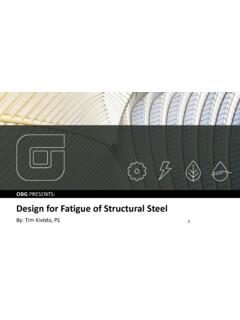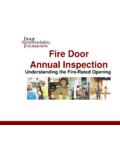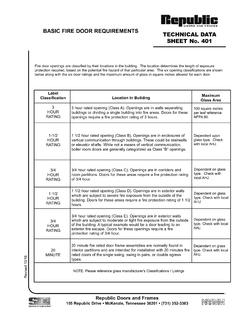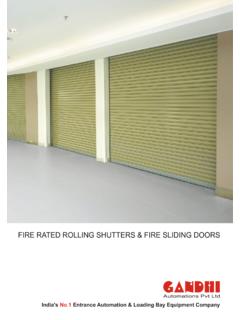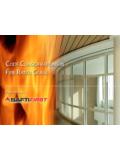Transcription of Fire-Resistance-Rated Construction and the IBC
1 Fire-Resistance-Rated Construction and the IBC Chad R. Barnes Marsh Risk Consulting Agenda Introductions Objectives fire Protection Methodologies Passive fire Protection Common Standards Governing Passive fire Protection International Building Code Chapter 7: fire and Smoke Protection Features In Review Closeout OBJECTIVES Fire-Resistance-Rated Construction and the IBC Objectives Terminal Utilizing the International Building Code, correctly apply Chapter 7, fire and Smoke Protection Features, to understand the different types of Fire-Resistance-Rated Construction definitions, components, and systems. Objectives (cont.) Enabling Develop an understanding of the core fire protection principles/methodologies and how when balanced, they present the fire protection tetrahedron Utilizing a case study, gain an understanding of the affect passive fire protection has on life and fire safety in vertical Construction Define passive fire protection and the components of a passive fire protection program Develop an understanding of the different nationally recognized standards that govern passive fire protection components/systems testing and listings Develop an understanding of Chapter 7 of the IBC, its definitions.
2 And how passive fire protection is applied to a structure fire PROTECTION METHODOLOGIES Fire-Resistance-Rated Construction and the IBC fire Protection Methodologies Active fire Protection Prevention/ITM Automatic/manual fire alarm/detection Automatic/manual fire suppression Passive fire Protection fire and smoke barriers fire Protection Methodologies (cont.) The fire Protection Tetrahedron - Prevention, Inspection, and Maintenance - fire Alarm and Detection - fire Suppression fire and Smoke Barriers - PASSIVE fire PROTECTION Fire-Resistance-Rated Construction and the IBC Passive fire Protection MGM Grand Hotel fire Nov. 21, 1980 Las Vegas Nevada 679 injured, 84 dead Openings in vertical shafts and seismic joints acted as chimneys spreading smoke and heat all they way up to the 26th floor 68 people died on 23rd floor from asphyxia fire alarm system destroyed before alarms could be activated Passive fire Protection (cont.)
3 Definition: The containment of fire via the use of Construction materials in rated assemblies/systems ( walls, floors, ceilings, etc.). Organization of the building into smaller compartments prevents and/or slows the spread of fire from the room of origin, limiting smoke/ fire damage and giving occupants longer to evacuate the building. Passive fire Protection (cont.) Components of a passive fire protection program: Structural fire protection Compartmentation Opening protectives Through penetration protection Passive fire Protection (cont.) Structural fire protection Protection of essential building structural elements from the effects of heat/ fire to help prevent/delay catastrophic failure of structural steel which leads to partial or full building collapse. Done through spray on cementitious materials or intumescent products such as paint. Can also be done with concrete and gypsum board encasement.
4 Passive fire Protection (cont.) Compartmentation fire and smoke barriers used to limit the spread of smoke in a building and give occupants sufficient time for evacuation. Includes fire barriers, fire walls, fire partitions, and smoke barriers. Can be Construction of masonry, gypsum, or other approved listed materials/systems. Passive fire Protection (cont.) Opening Protectives fire rated door and window assemblies, including frames and hardware are installed in fire rated barriers to maintain fire resistance of barrier (floor, wall, etc.). Opening protectives are rated assemblies. Passive fire Protection (cont.) Through Penetration Protection Materials utilized to limit the spread of fire and/or smoke through a penetration in a fire barrier. Done through packing intumescent materials and other items into void spaces to achieve desired rating. All materials comprise a listed system.
5 Penetrations, Construction joints, membrane penetrations, etc. COMMON STANDARDS GOVERNING PASSIVE fire PROTECTION Fire-Resistance-Rated Construction and the IBC Common Standards Governing Passive fire Protection UFC 3-600-1 - fire Protection Engineering for Facilities International Building Code GA-600 Gypsum Association fire resistance Design Manual ASTM E 119 Test Methods for fire Tests of Building Construction Materials UL 263 Standard for fire Test of Building Construction Materials ASTM E 814 Test Method of fire Tests of Through-penetration Firestops UL 1479 fire Tests of Through-penetration Firestops ASTM E 1966 Test Method for fire -resistant Joint Systems Common Standards Governing Passive fire Protection (cont.) UL 2079 Tests for fire - resistance of Building Joint Systems NFPA 80 fire Doors and Other Opening Protectives NFPA 101 Life Safety Code NFPA 105 Standard for the Installation of Smoke Door Assemblies NFPA 252 Standard Methods of fire Tests of Door Assemblies NFPA 257 Standard for fire Test for Window and Glass Block Assemblies FCIA (Firestop Contractors International Association) Manual of Practice Common Standards Governing Passive fire Protection (cont.)
6 FM 4991 Approval Standard for Approval of Firestop Contractors UL Qualified Firestop Contractor Program INTERNATIONAL BUILDING CODE CHAPTER 7 Fire-Resistance-Rated Construction and the IBC International Building Code - Chapter 7 Section 701 General Scope. The provisions of this chapter shall govern the materials, systems and assemblies used for structural fire resistance and Fire-Resistance-Rated Construction separation of adjacent spaces to safeguard against the spread of fire and smoke within a building and the spread of fire to or from buildings. International Building Code - Chapter 7 (cont.) Scope Governs the materials and assemblies used for structural fire resistance and Fire-Resistance-Rated Construction . Safeguards against the spread of fire and smoke within a building, and from building to building. PASSIVE fire PROTECTION International Building Code - Chapter 7 (cont.)
7 Section 702 Definitions fire Barrier fire Partition fire - resistance Rating fire Wall Horizontal Assembly Smoke Barrier Smoke Compartment International Building Code - Chapter 7 (cont.) fire Barrier A Fire-Resistance-Rated wall assembly of materials designed to restrict the spread of fire in which continuity is maintained Generally between fire areas International Building Code - Chapter 7 (cont.) fire Partition A vertical assembly of materials designed to restrict the spread of fire in which openings are protected Generally a part of means of egress International Building Code - Chapter 7 (cont.) fire resistance -Rating The period of time a building element, component or assembly maintains the ability to confine a fire , continues to perform a given structural function, or both, as determined by the tests, or the methods based on tests, prescribed in Section 703 International Building Code - Chapter 7 (cont.)
8 fire Wall A Fire-Resistance-Rated wall having protected openings, which restricts the spread of fire and extends continuously from the foundation to or through the roof, with sufficient structural stability under fire conditions to allow collapse of Construction on either side without collapse of the wall. Generally separates buildings and/or occupancies International Building Code - Chapter 7 (cont.) Horizontal Assembly A Fire-Resistance-Rated floor or roof assembly of materials designed to restrict the spread of fire in which continuity is maintained International Building Code - Chapter 7 (cont.) Smoke Barrier A continuous membrane, either vertical or horizontal, such as a wall, floor or ceiling assembly, that is designed and constructed to resist the movement of smoke International Building Code - Chapter 7 (cont.) Smoke Compartment A space within a building enclosed by smoke barriers on all sides, including the top and bottom International Building Code - Chapter 7 (cont.)
9 Walls/Vertical fire Wall fire Barrier fire Partition Floors/Ceil/Roof Horizontal Assembly Smoke Compartment Smoke Barrier International Building Code - Chapter 7 (cont.) Section 703 fire - resistance Ratings and fire Te s t s fire resistance is determined using the test procedures of test standard ASTM E 119 or by calculations and analyses that have the principle test criteria of ASTM E 119 as a basis. Alternative methods for determining fire resistance . International Building Code - Chapter 7 (cont.) Section 704 fire - resistance Rating of Structural Members Requirements. The fire - resistance ratings of structural members and assemblies shall comply with this section and the requirements for the type of Construction as specified in Table 601. The fire - resistance ratings shall not be less than the ratings required for the Fire-Resistance-Rated assemblies supported by the structural members.
10 International Building Code - Chapter 7 (cont.) Chapter 6 Types of Construction Table 601 fire - resistance Rating Requirements for Building Elements (hours) International Building Code - Chapter 7 (cont.) TABLE 601 fire - resistance RATING REQUIREMENTS FOR BUILDING ELEMENTS (hours) BUILDING ELEMENT TYPE I TYPE II TYPE III TYPE IV TYPE V A B Ad B Ad B HT Ad B Primary structural frameg (see Section 202) 3a 2a 1 0 1 0 HT 1 0 Bearing walls Exteriorf, g Interior 3 3a 2 2a 1 1 0 0 2 1 2 0 2 1/HT 1 1 0 0 Nonbearing walls and partitions Exterior See Table 602 Nonbearing walls and partitions Interiore 0 0 0 0 0 0 See Section 0 0 Floor Construction and secondary members (see Section 202) 2 2 1 0 1 0 HT 1 0 Roof Construction and secondary members (see Section 202) 11/2b 1b,c 1b,c 0c 1b,c 0 HT 1b,c 0 International Building Code - Chapter 7 (cont.)




